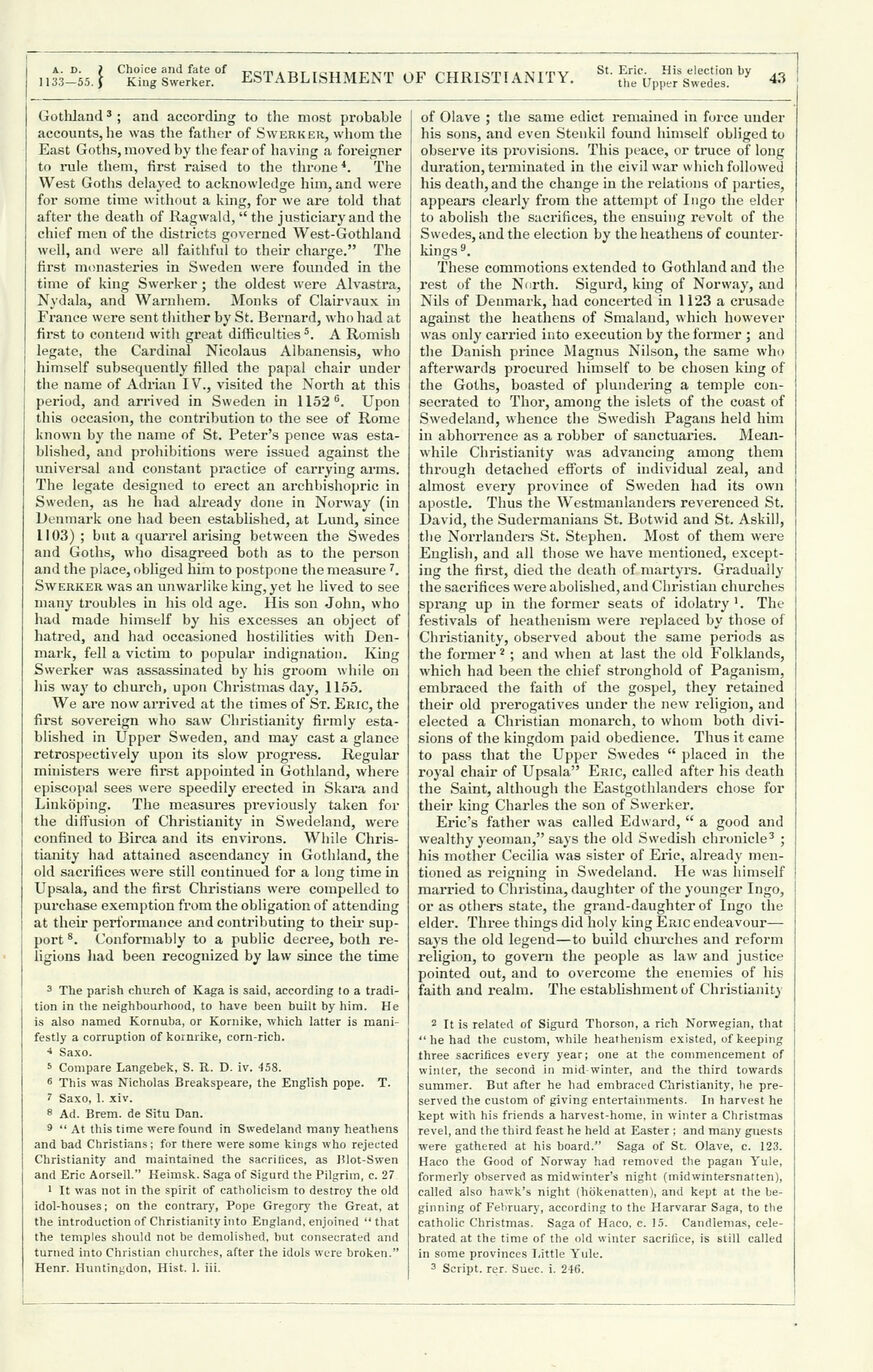
Full resolution (JPEG) - On this page / på denna sida - III. Establishment of Christianity. Contests of the Swedes and Goths for Supremacy. A.D. 800—1250

<< prev. page << föreg. sida << >> nästa sida >> next page >>
Below is the raw OCR text
from the above scanned image.
Do you see an error? Proofread the page now!
Här nedan syns maskintolkade texten från faksimilbilden ovan.
Ser du något fel? Korrekturläs sidan nu!
This page has been proofread at least once.
(diff)
(history)
Denna sida har korrekturlästs minst en gång.
(skillnad)
(historik)
East-Gothland [1]; and according to the most probable
accounts, he was the father of Swerker, whom the
East Goths, moved by the fear of having a foreigner
to rule them, first raised to the throne [2]. The
West Goths delayed to acknowledge him, and were
for some time without a king, for we are told that
after the death of Ragwald, “the justiciary and the
chief men of the districts governed West-Gothland
well, and were all faithful to their charge.” The
first monasteries in Sweden were founded in the
time of king Swerker; the oldest were Alvastra,
Nydala, and Warnhem. Monks of Clairvaux in
France were sent thither by St. Bernard, who had at
first to contend with great difficulties [3]. A Romish
legate, the Cardinal Nicolaus Albanensis, who
himself subsequently filled the papal chair under
the name of Adrian IV., visited the North at this
period, and arrived in Sweden in 1152 [4]. Upon
this occasion, the contribution to the see of Rome
known by the name of St. Peter’s pence was
established, and prohibitions were issued against the
universal and constant practice of carrying arms.
The legate designed to erect an archbishopric in
Sweden, as he had already done in Norway (in
Denmark one had been established, at Lund, since
1103); but a quarrel arising between the Swedes
and Goths, who disagreed both as to the person
and the place, obliged him to postpone the measure [5].
Swerker was an unwarlike king, yet he lived to see
many troubles in his old age. His son John, who
had made himself by his excesses an object of
hatred, and had occasioned hostilities with
Denmark, fell a victim to popular indignation. King
Swerker was assassinated by his groom while on
his way to church, upon Christmas day, 1155.
We are now arrived at the times of St. Eric, the
first sovereign who saw Christianity firmly established
in Upper Sweden, and may cast a glance
retrospectively upon its slow progress. Regular
ministers were first appointed in Gothland, where
episcopal sees were speedily erected in Skara and
Linköping. The measures previously taken for
the diffusion of Christianity in Swedeland, were
confined to Birca and its environs. While
Christianity had attained ascendancy in Gothland, the
old sacrifices were still continued for a long time in
Upsala, and the first Christians were compelled to
purchase exemption from the obligation of attending
at their performance and contributing to their
support [6]. Conformably to a public decree, both
religions had been recognized by law since the time
of Olave; the same edict remained in force under
his sons, and even Stenkil found himself obliged to
observe its provisions. This peace, or truce of long
duration, terminated in the civil war which followed
his death, and the change in the relations of parties,
appears clearly from the attempt of Ingo the elder
to abolish the sacrifices, the ensuing revolt of the
Swedes, and the election by the heathens of
counter-kings [7].
These commotions extended to Gothland and the
rest of the North. Sigurd, king of Norway, and
Nils of Denmark, had concerted in 1123 a crusade
against the heathens of Smaland, which however
was only carried into execution by the former; and
the Danish prince Magnus Nilson, the same who
afterwards procured himself to be chosen king of
the Goths, boasted of plundering a temple
consecrated to Thor, among the islets of the coast of
Swedeland, whence the Swedish Pagans held him
in abhorrence as a robber of sanctuaries.
Meanwhile Christianity was advancing among them
through detached efforts of individual zeal, and
almost every province of Sweden had its own
apostle. Thus the Westmanlanders reverenced St.
David, the Sudermanians St. Botwid and St. Askill,
the Norrlanders St. Stephen. Most of them were
English, and all those we have mentioned, excepting
the first, died the death of martyrs. Gradually
the sacrifices were abolished, and Christian churches
sprang up in the former seats of idolatry [8]. The
festivals of heathenism were replaced by those of
Christianity, observed about the same periods as
the former [9]; and when at last the old Folklands,
which had been the chief stronghold of Paganism,
embraced the faith of the gospel, they retained
their old prerogatives under the new religion, and
elected a Christian monarch, to whom both divisions
of the kingdom paid obedience. Thus it came
to pass that the Upper Swedes “placed in the
royal chair of Upsala” Eric, called after his death
the Saint, although the Eastgothlanders chose for
their king Charles the son of Swerker.
Eric’s father was called Edward, “a good and
wealthy yeoman,” says the old Swedish chronicle [10];
his mother Cecilia was sister of Eric, already
mentioned as reigning in Swedeland. He was himself
married to Christina, daughter of the younger Ingo,
or as others state, the grand-daughter of Ingo the
elder. Three things did holy king Eric endeavour—says
the old legend—to build churches and reform
religion, to govern the people as law and justice
pointed out, and to overcome the enemies of his
faith and realm. The establishment of Christianity
<< prev. page << föreg. sida << >> nästa sida >> next page >>